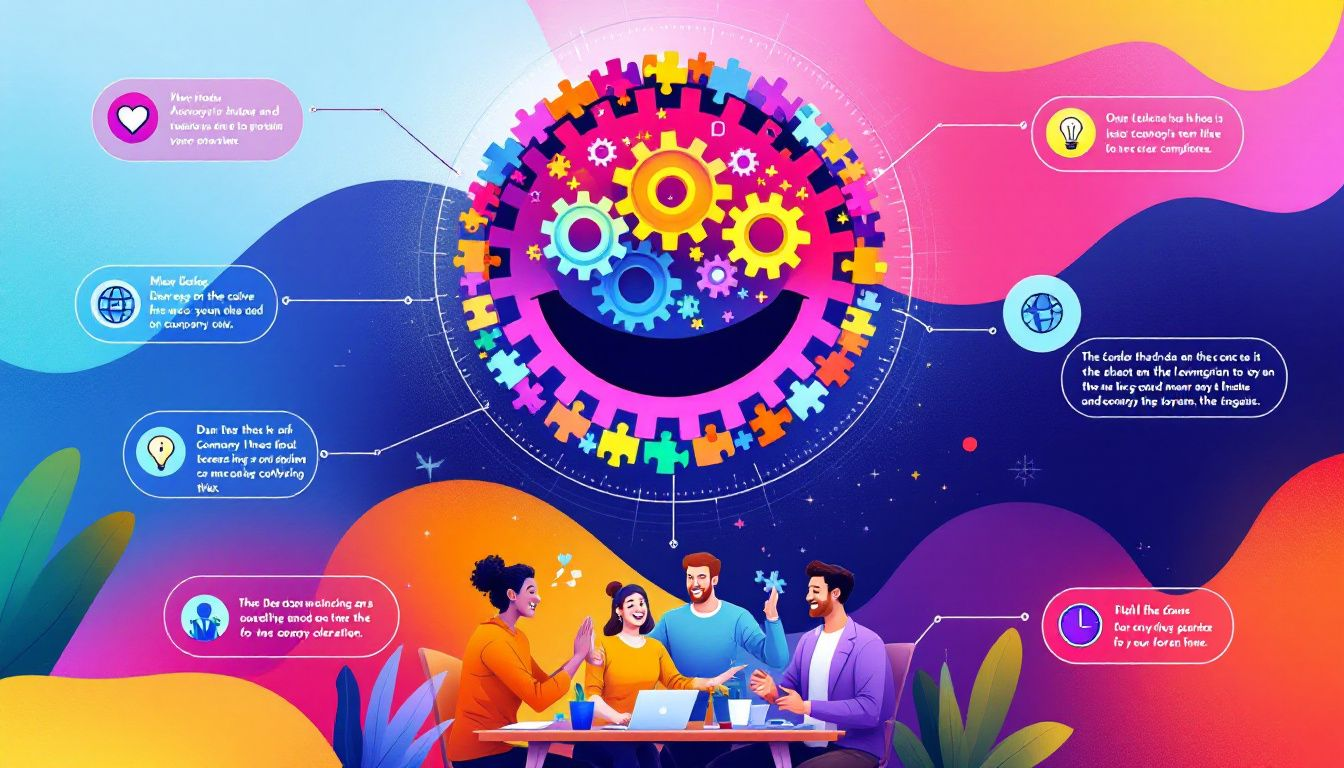Employee engagement is crucial for any organization aiming for success. It refers to how emotionally connected employees are to their work and workplace. Engaged employees are more productive, stay longer, and positively impact company culture. This article covers effective strategies to improve engagement, ways to measure engagement, and how to tackle challenges in maintaining it.
Key Takeaways
- Employee engagement is crucial for productivity and retention, with engaged employees boosting productivity by up to 18% and reducing turnover by 21%.
- Key strategies for enhancing employee engagement include promoting open communication, recognizing contributions, and investing in career development opportunities.
- Regular measurement and feedback utilization are essential for ongoing employee engagement improvements, as they help organizations address challenges and adapt strategies effectively.
Understanding Employee Engagement

Employee engagement is more than just a buzzword; it’s the lifeblood of a thriving organization. Gallup defines employee engagement as the involvement of employees in their work. It also refers to their enthusiasm for the workplace. This definition captures the essence of what it means to be engaged: employees who are not just present but are actively contributing, collaborating, and showing a genuine interest in their roles.
Differentiating between employee engagement and employee satisfaction is important. Although satisfaction indicates engagement, they are not the same. Engaged employees go beyond satisfaction; they are proactive, enthusiastic, and committed to helping the organization achieve its goals. They feel that their opinions matter, which reinforces their connection to the company.
On the flip side, disengaged employees often harbor negative perceptions of their workplace, leading to a lack of commitment and connection to the organization’s mission. Understanding these dynamics is the first step towards creating a workplace where employees feel valued and motivated.
The Importance of Employee Engagement

Why is employee engagement important? The answer lies in its profound impact on productivity, retention, and overall business success. Engaged employees can increase productivity by up to 18%, making them invaluable assets to any organization. To engage employees, they are more likely to work harder, stay longer, and inspire other employees, creating a ripple effect that boosts overall performance.
High levels of engagement are also linked to better employee retention. Employees who feel engaged are more likely to stay with the company, demonstrating loyalty and reducing turnover rates by 21%. This not only saves costs associated with recruiting and training new employees but also ensures continuity and stability within the organization to increase employee engagement.
Moreover, the financial benefits of employee engagement are significant. Organizations that prioritize engagement report 24% higher profitability, a testament to the positive impact on business outcomes. Engaged employees lead to better customer retention and talent acquisition, highlighting the importance of fostering a culture of engagement.
Investing in employee engagement is not just a strategic move; it’s a reflection of leadership actions and a key metric for organizational success. By prioritizing engagement, companies can unlock the full potential of their workforce, driving sustainable growth and success.
Key Drivers of Employee Engagement
Knowing what drives employee engagement is essential for creating effective strategies. Leadership support and clear communication are foundational elements that foster a positive work atmosphere and build trust among employees. When employees feel supported and informed, they are more likely to engage actively with their work and the organization’s goals.
Another key driver is the alignment of employees with the organization’s values and purpose. Employees who feel that their personal values align with those of the company exhibit higher levels of engagement. This alignment creates a sense of belonging and commitment, motivating employees to contribute meaningfully to the organization’s success.
Innovation also plays a significant role in driving engagement. Engaged employees often exhibit innovative thinking, helping to develop new solutions and improve workflows. By fostering an environment that encourages creativity and innovation, organizations can keep their workforce engaged and motivated.
Effective Employee Engagement Strategies

Implementing effective employee engagement strategies is essential for fostering a motivated and productive workforce. Setting clear goals is a vital component of any employee engagement strategy, as it guides actions and efforts towards specific outcomes. However, engagement is not a one-time effort; it requires continuous feedback and improvement to adapt to the evolving needs of employees and organizational goals.
Three key strategies can significantly enhance engagement: promoting open and honest communication, recognizing and rewarding employee contributions, and investing in career development opportunities. These strategies create a comprehensive approach that addresses various aspects of engagement, from communication to recognition and growth.
The following subsections offer practical tips and insights for creating a more engaged and motivated workforce.
Promote Open and Honest Communication
Transparency in communication is a cornerstone of effective employee engagement strategies. When management practices transparency, it fosters trust and boosts engagement. This includes being open about workplace practices, such as salary discussions, which can significantly enhance employees’ trust in the organization.
Encouraging two-way communication is equally important. Organizations should create safe spaces where employees feel comfortable sharing their ideas and concerns. This not only leads to a more inclusive and innovative workplace culture but also ensures that employees feel heard and valued.
Various tools and practices can help maintain open lines of communication. A well-structured intranet, regular team meetings, and clear documentation are effective ways to keep communication channels open and ensure that employees stay informed and engaged.
Recognize and Reward Employee Contributions
Recognition is a powerful driver of employee engagement. Acknowledging and rewarding employee achievements can significantly enhance morale and reinforce positive behaviors. It is one of the simplest yet most effective ways to improve employee engagement.
There are various forms of recognition, both monetary and non-monetary, that can be employed to create a recognition-rich environment. Monetary incentives such as bonuses and pay raises are effective, but simple acknowledgments, such as public praise or personalized thank-you notes, can also have a profound impact.
Failing to recognize employees’ efforts can lead to disengagement and lower morale. Organizations should consistently acknowledge and reward hard work to sustain high levels of engagement and productivity.
Invest in Career Development Opportunities
Career development opportunities are crucial for retaining employees and enhancing overall engagement. These opportunities signal a company’s commitment to employees’ long-term success, fostering loyalty and motivation.
A clear career path helps employees understand their growth potential within the organization, which can significantly boost their engagement and job satisfaction. Regularly outlining these paths and providing the necessary support for career development can lead to a more motivated and productive workforce.
Investing in development opportunities is particularly important for frontline workers, who often seek growth and advancement. By providing these opportunities, organizations can boost engagement and loyalty, ensuring that employees feel valued and supported in their career journeys.
Measuring Employee Engagement

Measuring employee engagement is a critical step in understanding and enhancing it. Companies with highly engaged employees see a significant reduction in lost productivity, highlighting the importance of accurate measure employee engagement. Employee engagement surveys are the most widely used and dependable method for quantifying engagement levels. These employee engagement measures provide a structured way to gather employee feedback, helping organizations identify areas for improvement and track progress over time.
However, relying solely on annual engagement surveys can be limiting. Organizations need more frequent and comprehensive measures to fully understand engagement dynamics and respond effectively to changes. By regularly analyzing engagement metrics, companies can make informed decisions and adjust their strategies to maintain high levels of engagement.
Designing Effective Employee Engagement Surveys
Effective survey questions are vital for accurately understanding the factors influencing employee engagement. Questions should be scientifically proven to measure engagement and cover various aspects of the employee experience, such as individual empowerment, team alignment, and connection to the company while designing employee engagement surveys. Additionally, employee engagement survey questions should be crafted to elicit meaningful feedback.
Using a 5-point Likert scale and standard measurement scales can improve the quality of survey data. Well-structured surveys targeting different organizational levels can enhance response rates and provide a holistic view of engagement.
To achieve accurate and actionable insights, surveys should include a mix of closed and open-ended questions. This approach allows employees to provide detailed feedback and examples, helping organizations understand the nuances of engagement and identify specific areas for improvement.
Utilizing Employee Engagement Software
Employee engagement software can be a game-changer for organizations looking to enhance engagement through an employee engagement program. These tools provide insights into driving and stalling factors, capture feedback, and facilitate targeted action through an employee engagement platform.
Effective engagement software includes features such as pre-built survey designs, standardized datasets, and real-time dashboards. These features enable organizations to measure, track, and improve employee satisfaction and productivity systematically, aligning with an effective employee engagement model.
Selecting the appropriate software partner is essential. It plays a vital role in achieving successful engagement initiatives. The right partner can provide actionable insights and advice for leaders and managers, helping them implement effective strategies and drive positive outcomes.
Overcoming Challenges in Employee Engagement Efforts
Despite the best intentions, organizations often face challenges in their employee engagement efforts. Measuring engagement helps identify strategic changes necessary for enhancing staff and overall company culture. However, complex procedures can inhibit engagement, making it essential to simplify these processes for productivity.
Establishing focus groups can be an effective way to address specific challenges. These groups allow for open discussion and collective problem-solving, helping organizations understand and tackle issues that may hinder engagement.
Regular communication about the progress of engagement initiatives is also vital. Sharing updates and results fosters accountability and keeps engagement a priority in organizational discussions.
Lack of Leadership Support
Leadership support is critical in establishing a strong foundation for employee engagement initiatives. When leaders actively support and participate in engagement efforts, it sets a positive example and encourages employees to engage fully with their work and the organization’s goals.
Without leadership support, engagement initiatives often lack credibility and fail to gain the necessary traction for success. Therefore, it’s essential for leaders to champion these efforts and demonstrate their commitment to fostering a positive workplace culture.
Difficulty in Acting on Feedback
One of the most significant challenges in employee engagement efforts is the difficulty in translating feedback into tangible actions. Only 35% of employees feel their organization is effective at taking action post-survey, which leaves a considerable gap in employee perceptions. This discrepancy can lead to disillusionment and decreased morale among employees if not addressed properly.
Having a structured plan for communicating survey results and subsequent actions is crucial for effectively utilizing employee engagement survey results. A robust feedback loop model, which continuously gathers insights and implements changes, is necessary for long-term improvements. This approach not only demonstrates that employee feedback is valued but also fosters a culture of continuous improvement.
To overcome this challenge, organizations can benefit from finding a software partner for action-oriented surveying. Such tools can help in making sense of survey results and directing insights to the right stakeholders, ensuring that feedback leads to effective actions and sustained engagement improvements.
Creating an Employee Engagement Action Plan
An employee engagement action plan is essential for transforming workplace dynamics by turning insights into actions. For an action plan to be effective, it should be specific, measurable, and well-communicated. Identifying key drivers of engagement within the organization and focusing on two to three priority areas can optimize the impact on overall employee engagement.
Key aspects of action planning include visibility, accountability, and reducing time-to-action. Utilizing a template for the action plan can streamline the process of identifying problems and solutions effectively. Additionally, maintaining action after launching the plan is crucial to stay on course and adjust strategies as needed based on ongoing feedback and results.
During implementation, it’s important to communicate progress on the action plan and survey results to keep everyone informed and engaged. Starting small, being specific, and building one driver at a time can help organizations create a sustainable and impactful engagement action plan.
The Role of Managers in Employee Engagement
Managers play a pivotal role in shaping employee engagement, as they have direct, day-to-day interactions with team members. Employees often feel more connected to their immediate manager than to HR, making the manager’s influence crucial in driving engagement. This connection underscores the importance of managers in fostering a supportive and engaging work environment.
Providing regular, timely feedback is more effective for maintaining engagement compared to traditional annual performance reviews. Managers should communicate consistently with their teams, set clear expectations, and conduct regular one-on-one meetings to build engagement and reduce misunderstandings.
Recognition from managers can significantly enhance engagement, often more than financial incentives. By actively safeguarding employee well-being and fostering personal autonomy in task execution, managers can drive higher levels of engagement and performance.
Employee Engagement Best Practices

Establishing a recognition-rich culture is one of the most effective best practices for boosting employee morale and encouraging high performance. Public acknowledgment of achievements can serve as a powerful non-monetary incentive that significantly enhances employee engagement. However, it’s important to follow through on feedback and avoid overusing pulse surveys without taking meaningful action, as this can lead to employee disengagement.
Implementing an employee feedback loop model helps ensure that feedback leads to sustainable improvements in engagement. This approach involves continuously gathering, analyzing, and acting on employee feedback to create a culture of continuous improvement and responsiveness.
Organizations should be diligent in addressing survey feedback and demonstrating that employee input is valued and acted upon. By doing so, they can foster a positive workplace environment where employees feel valued, engaged, and motivated to contribute to the organization’s success.
Summary
In summary, employee engagement is a vital component of organizational success, driving productivity, retention, and overall business outcomes. By understanding the key drivers of engagement and implementing effective strategies, organizations can create a motivated and committed workforce. Promoting open communication, recognizing achievements, and investing in career development are essential strategies for fostering engagement.
Measuring employee engagement through surveys and utilizing engagement software can provide valuable insights for continuous improvement. Overcoming challenges such as lack of leadership support and difficulty in acting on feedback requires a structured approach and commitment to transparency and action.
Ultimately, creating an employee engagement action plan and empowering managers to drive engagement can lead to a thriving workplace culture where employees feel valued and motivated. Implementing these best practices will not only enhance employee satisfaction but also contribute to better business outcomes and organizational success.
Frequently Asked Questions
What is the difference between employee engagement and employee satisfaction?
Employee engagement is the level of involvement and enthusiasm employees have towards their work, whereas employee satisfaction measures how content they are with their job. While satisfaction can reflect engagement, it does not encompass the full depth of an employee’s commitment and passion for their role.
Why is employee engagement important for organizations?
Employee engagement is key to enhancing productivity and retention within organizations. Engaged employees not only perform better but also contribute to improved financial results and a positive workplace culture.
What are some key drivers of employee engagement?
Leadership support, clear communication, alignment with organizational values, and fostering innovative thinking are key drivers of employee engagement. Prioritizing these elements cultivates trust, motivation, and a sense of belonging within the workforce.
How can organizations measure employee engagement effectively?
To effectively measure employee engagement, organizations should implement well-designed surveys that combine both closed and open-ended questions, ensuring frequent assessments and leveraging engagement software for deeper insights. This approach allows for continuous improvement in engagement strategies.
What role do managers play in employee engagement?
Managers are essential in driving employee engagement by providing regular feedback, recognizing achievements, and fostering a supportive work environment. Their interactions with team members directly influence engagement levels.
